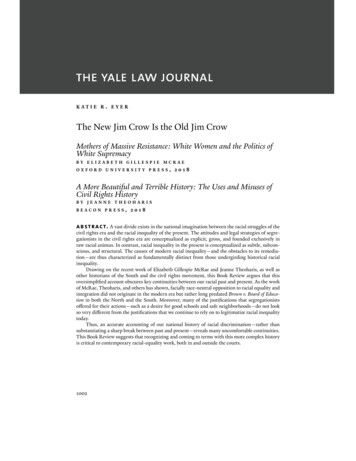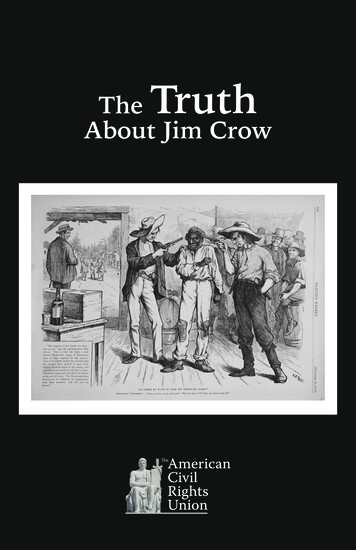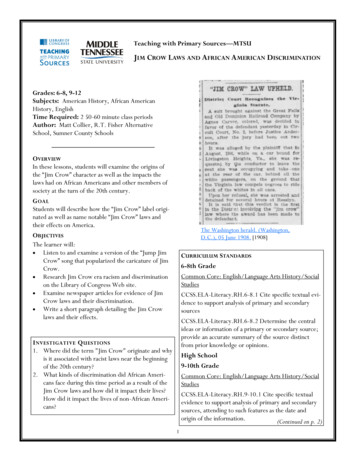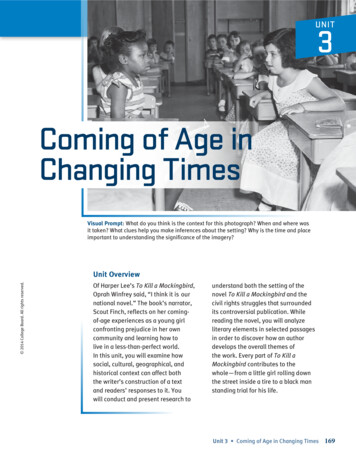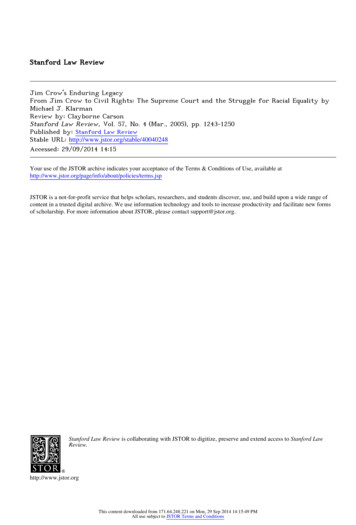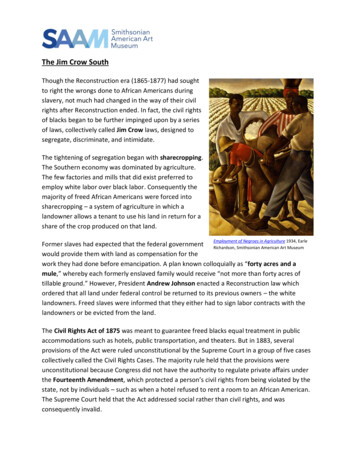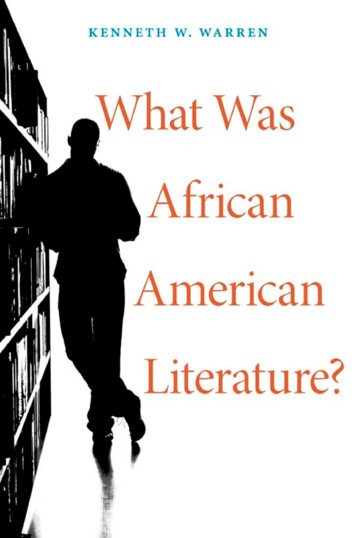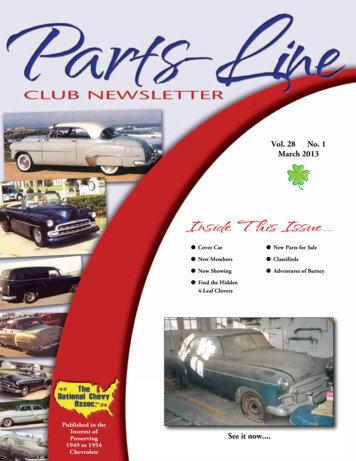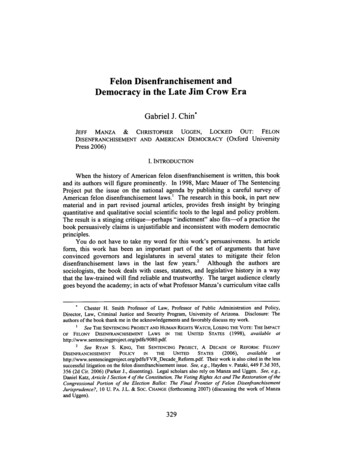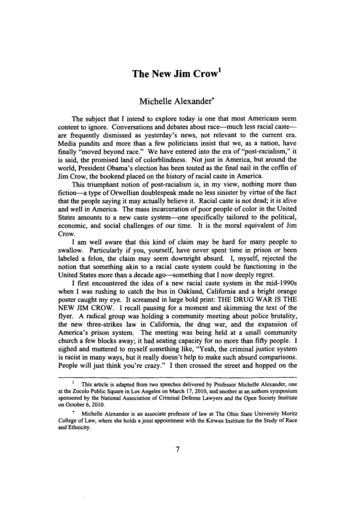
Transcription
The New Jim Crow'Michelle Alexander*The subject that I intend to explore today is one that most Americans seemcontent to ignore. Conversations and debates about race-much less racial casteare frequently dismissed as yesterday's news, not relevant to the current era.Media pundits and more than a few politicians insist that we, as a nation, havefinally "moved beyond race." We have entered into the era of "post-racialism," itis said, the promised land of colorblindness. Not just in America, but around theworld, President Obama's election has been touted as the final nail in the coffin ofJim Crow, the bookend placed on the history of racial caste in America.This triumphant notion of post-racialism is, in my view, nothing more thanfiction-a type of Orwellian doublespeak made no less sinister by virtue of the factthat the people saying it may actually believe it. Racial caste is not dead; it is aliveand well in America. The mass incarceration of poor people of color in the UnitedStates amounts to a new caste system-one specifically tailored to the political,economic, and social challenges of our time. It is the moral equivalent of JimCrow.I am well aware that this kind of claim may be hard for many people toswallow. Particularly if you, yourself, have never spent time in prison or beenlabeled a felon, the claim may seem downright absurd. I, myself, rejected thenotion that something akin to a racial caste system could be functioning in theUnited States more than a decade ago-something that I now deeply regret.I first encountered the idea of a new racial caste system in the mid-1990swhen I was rushing to catch the bus in Oakland, California and a bright orangeposter caught my eye. It screamed in large bold print: THE DRUG WAR IS THENEW JIM CROW. I recall pausing for a moment and skimming the text of theflyer. A radical group was holding a community meeting about police brutality,the new three-strikes law in California, the drug war, and the expansion ofAmerica's prison system. The meeting was being held at a small communitychurch a few blocks away; it had seating capacity for no more than fifty people. Isighed and muttered to myself something like, "Yeah, the criminal justice systemis racist in many ways, but it really doesn't help to make such absurd comparisons.People will just think you're crazy." I then crossed the street and hopped on the1 This article is adapted from two speeches delivered by Professor Michelle Alexander, oneat the Zocolo Public Square in Los Angeles on March 17, 2010, and another at an authors symposiumsponsored by the National Association of Criminal Defense Lawyers and the Open Society Instituteon October 6, 2010.* Michelle Alexander is an associate professor of law at The Ohio State University MoritzCollege of Law, where she holds a joint appointment with the Kirwan Institute for the Study of Raceand Ethnicity.7
OHIO STATE JOURNAL OF CRIMNAL LAW8[Vol 9: 1bus. I was headed to my new job, director of the Racial Justice Project for theACLU in Northern California.When I began my work at the ACLU, I assumed the criminal justice systemhad problems of racial bias, much in the same way that all major institutions in oursociety are plagued to some degree with problems associated with conscious andunconscious bias. As a civil rights lawyer, I had litigated numerous class-actionemployment discrimination cases, and I understood well the many ways in whichracial stereotyping can permeate subjective decision-making processes at all levelsof an organization with devastating consequences. While at the ACLU, I shiftedmy focus from employment discrimination to criminal justice reform, anddedicated myself to the task of working with others to identify and eliminate racialbias whenever and wherever it reared its ugly head.By the time I left the ACLU, I had come to suspect that I was wrong about thecriminal justice system. It was not just another institution infected with racial bias,but rather a different beast entirely. The activists who posted the sign on thetelephone phone were not crazy; nor were the smattering of lawyers and advocatesaround the country who were beginning to connect the dots between our currentsystem of mass incarceration and earlier forms of social control. Quite belatedly, Icame to see that mass incarceration in the United States had, in fact, emerged as astunningly comprehensive and well-disguised system of racialized social controlthat functions in a manner strikingly similar to Jim Crow.I state my basic thesis in the introduction to my book, The New Jim Crow:What has changed since the collapse of Jim Crow has less to dowith the basic structure of our society than the language we use to justifyit. In the era of colorblindness, it is no longer socially permissible to userace, explicitly, as a justification for discrimination, exclusion, and socialcontempt. So we don't. Rather than rely on race, we use our criminaljustice system to label people of color "criminals" and then engage in allthe practices we supposedly left behind. Today it is perfectly legal todiscriminate against criminals in nearly all the ways it was once legal todiscriminate against African Americans. Once you're labeled a felon,the old forms of discrimination-employment discrimination, housingdiscrimination, denial of the right to vote, and exclusion from juryservice-are suddenly legal. As a criminal, you have scarcely morerights, and arguably less respect, than a black man living in Alabama atthe height of Jim Crow. We have not ended racial caste in America; wehave merely redesigned it.2I reached this conclusion reluctantly. Like many civil rights lawyers, I wasinspired to attend law school by the civil rights victories of the 1950s and 1960s.2MICHELLE ALEXANDER, THE NEW JIM CROW: MASS INCARCERATION IN THE AGE OFCOLORBLINDNEsS 2 (2010),
2011]THE NEWJIMCROW9Even in the face of growing social and political opposition to remedial policiessuch as affirmative action, I clung to the notion that the evils of Jim Crow arebehind us and that, while we have a long way to go to fulfill the dream of anegalitarian, multiracial democracy, we have made real progress. I understood theproblems plaguing poor communities of color, including problems associated withcrime and rising incarceration rates, to be a function of poverty and lack of accessto quality education-the continuing legacy of slavery and Jim Crow. Istrenuously resisted the idea that a new caste system was operating in this country;I was nearly offended by the notion. But after years of working on issues of racialprofiling, police brutality, drug law enforcement in poor communities of color, andattempting to assist people released from prison "re-enter" into a society that neverseemed to have much use for them in the first place, I had a series of experiencesthat began what I call my "awakening." I began to awaken to a racial reality that isso obvious to me now that what seems odd in retrospect is that I was blind to it forso long.Here are some facts I uncovered in the course of my work and research thatyou probably have not heard on the evening news:***More African American adults are under correctional controltoday-in prison or jail, on probation or parole-than were enslavedin 1850, a decade before the Civil War began.In 2007 more black men were disenfranchised than in 1870, the yearthe Fifteenth Amendment was ratified prohibiting laws thatexplicitly deny the right to vote on the basis of race.4 During theJim Crow era, African Americans continued to be denied access tothe ballot through poll taxes and literacy tests. Those laws havebeen struck down, but today felon disenfranchisement lawsaccomplish what poll taxes and literacy tests ultimately could not.In many large urban areas in the United States, the majority ofworking-age African American men have criminal records. In fact,it was reported in 2002 that, in the Chicago area, if you take intoaccount prisoners, the figure is nearly 80%.One in eleven black adults was under correctional supervision at year end 2007, orapproximately 2.4 million people. PEW CTR. ON THE STATES, PEW CHARITABLE TRUSTS, ONE IN 31:THE LONG REACH OF AMERICAN CORRECTIONS 5 (Mar. 2009), available s/PSPPlin3lreportFINALWEB 3-26-09.pdf.According to the 1850 Census, approximately 1.7 million adults (ages 15 and older) were slaves. U.S.CENSUS BUREAU, THE SEVENTH CENSUS OF THE UNITED STATES: 1850 9 (1853), available /1850a-01.pdf, see also University of u/php/state.php (last visited July 17, 2011).4 Contribution by Pamela S. Karlan, Forum: Pamela S. Karlan, in GLENN C. LOURY, RACE,INCARCERATION AND AMERICAN VALUES, 41, 42 (2008).5PAUL STREET, CHICAGO URBAN LEAGUE, THE VICIOUS CIRCLE: RACE, PRISON, JOBS, ANDCOMMUNITY IN CHICAGO, ILLINOIS, AND THE NATION 4 (2002).
OHIO STATE JOURNAL OF CRIMNAL LAW10o[Vol 9:1Those bearing criminal records and cycling in and out of our prisons today arepart of a growing undercaste-not class, caste-a group of people, defined largelyby race, who are relegated to a permanent second-class status by law. They can bedenied the right to vote, automatically excluded from juries, and legallydiscriminated against in employment, housing, access to education, and publicbenefits, much as their grandparents and great-grandparents were during the JimCrow era.I find that when I tell people that mass incarceration amounts to a New JimCrow, I am frequently met with shocked disbelief. The standard reply is: "Howcan you say that a racial caste system exists? Just look at Barack Obama! Justlook at Oprah Winfrey! Just look at the black middle class!"The reaction is understandable. But we ought to question our emotionalreflexes. The mere fact that some African Americans have experienced greatsuccess in recent years does not mean that something akin to a caste system nolonger exists. No caste system in the United States has ever governed all blackpeople. There have always been "free blacks" and black success stories, evenduring slavery and Jim Crow. During slavery, there were some black slaveowners-not many, but some. And during Jim Crow, there were some blacklawyers and doctors-not many, but some. The unprecedented nature of blackachievement in formerly white domains today certainly suggests that the old JimCrow is dead, but it does not necessarily mean the end of racial caste. If history isany guide, it may have simply taken a different form.Any honest observer of American racial history must acknowledge thatracism is highly adaptable. The rules and reasons the legal system employs toenforce status relations of any kind evolve and change as they are challenged.6 Inthe first chapter of the book, I describe the cyclical rebirths of racial caste inAmerica. Since our nation's founding, African Americans have been repeatedlycontrolled through institutions, such as slavery and Jim Crow, which appear to die,but then are reborn in new form-tailored to the needs and constraints of the time.For example, following the collapse of slavery, the system of convict leasingwas instituted-a system many historians believe was worse than slavery.7 Afterthe Civil War, black men were arrested by the thousands for minor crimes, such asloitering and vagrancy, and sent to prison. They were then leased to plantations. Itwas our nation's first prison boom. The idea was that prisoners leased toplantations were supposed to earn their freedom. But the catch was they couldnever earn enough to pay back the plantation owner the cost of their food, clothing6See, e.g., Reva Siegel, Why Equal ProtectionNo Longer Protects: The Evolving Forms ofStatus-EnforcingAction, 49 STAN. L. REv. 1111, 1113, 1146 (1997) (dubbing the process by whichwhite privilege is maintained, through the rules and rhetoric change, "preservation throughtransformation").DOUGLAS A. BLACKMON, SLAVERY BY ANOTHER NAME: THE RE-ENSLAVEMENT OF BLACKAMERICANS FROM THE CIVIL WAR TO WORLD WAR 11 (2008); DAVID M. OSHINSKY, WORSE THANSLAVERY: PARCHMAN FARM AND THE ORDEAL OF JIM CROW JUSTICE (1996).
20 11]THE NEW JIM CROW11and shelter to the owner's satisfaction, and thus they were effectively re-enslaved,sometimes for the rest of their lives. It was a system more brutal in many respectsthan slavery, because plantation owners had no economic incentive to keepconvicts healthy or even alive. They could always get another one.Today, I believe the criminal justice system has been used once again in amanner that effectively re-creates caste in America. Our criminal justice systemfunctions more like a caste system than a system of crime control.For those who find that claim difficult to swallow, consider the facts. Ourprison system has quintupled for reasons that have stunningly little do with crime.In less than 30 years, the U.S. penal population exploded from around 300,000 tomore than 2 million.9 The United States now has the highest rate of incarcerationin the world, dwarfing the rates of nearly every developed country, includinghighly repressive regimes like China and Iran.' 0In fact, if our nation were to return to the incarceration rates of the 1970s-atime, by the way, when civil rights activists thought that imprisonment rates wereegregiously high-we would have to release four out of five people who are inprison today." More than a million people employed by the criminal justicesystem could lose their jobs.12 That is how enormous and deeply entrenched thenew system has become in a very short period of time.As staggering as those figures are, they actually obscure the severity of thecrisis in poor communities of color. Professor Loic Wacquant has argued that theterm "mass incarceration" itself is a misnomer, since it implies that nearly8See id.9 Key Facts at a Glance: CorrectionalPopulations,BUREAU OF JUSTICE STATISTICS (updatedDec. 16, 2010), available at r2tab.cfm; JOHN IRWIN,ET AL., AMERICA'S ONE MILLION NONVIOLENT PRISONERS, THE JUSTICE POLICY INSTITUTE (1999),available at http://www.hawaii.edu/hivandaids/America s OneMillionNonviolent Prisoners.pdf;Robert Longley, U.S. Prison Population Tops 2 Million, U.S. GOVERNMENT atistic/a/aaprisonpop.htm.10 PEW CTR. ON THE STATES, ONE IN 100: BEHIND BARS IN AMERICA 2008, at 5 (Feb. Files/One%20in%20100.pdf.11 According to data provided by the Sentencing Project, in 1972, the total rate ofincarceration (prison and jail) was approximately 160 per 100,000. See MAUER, supra note 9, at 17.Today, it is about 750 per 100,000. LAUREN E. GLAZE, BUREAU OF JUSTICE STATISTICS, U.S. DEP'T OFJUSTICE, CORRECTIONAL POPULATIONS IN THE UNITED STATES, 2009, at 2 (2010), available pdf. A reduction of 79% would be needed to getback to the 160 figure-itself a fairly high number when judged by international standards.12According to a report released by the U.S. Department of Justice's Bureau of Statisticsin2006, the U.S. spent a record 185 billion for police protection, detention, judicial, and legalactivities in 2003. Adjusting for inflation, these figures reflect a tripling of justice expenditures since1982. The justice system employed almost 2.4 million people in 2003-58% of them at the locallevel and 31% at the state level. If four out of five people were released from prisons, far more than amillion people could lose their jobs. KRISTEN A. HUGHES, BUREAU OF JUSTICE STATISTICS, U.S. DEP'TOF JUSTICE, JUSTICE EXPENDITURE AND EMPLOYMENT IN THE UNITED STATES, 2003, at 1 (2006),availableat df
12OHIO STATE JOURNAL OF CRIMINAL LAW[Vol 9: Ieveryone has been subject to the new system of control.13 But, of course that is notthe case. The overwhelming majority of the increase in imprisonment has beenpoor people of color, with the most astonishing rates of incarceration found amongblack men. It was estimated several years ago that, in Washington, D.C.-ournation's capital-three out of four young black men (and nearly all those in thepoorest neighborhoods) could expect to serve time in prison. 14 Rates ofincarceration nearly as shocking can be found in other communities of color acrossAmerica.15So what accounts for this vast new system of control? Crime rates? That isthe common answer. But no, crime rates have remarkably little to do withskyrocketing incarceration rates. Crime rates have fluctuated over the past thirtyyears, and are currently at historical lows, but incarceration rates have consistentlysoared.' 6 Most criminologists and sociologists today acknowledge that crime ratesand incarceration rates have, for the most part, moved independently of oneanother. 17 Rates of imprisonment-especially black imprisonment-have soaredregardless of whether crime has been rising or falling in any given community orthe nation as a whole.18So what does explain this vast new system of control, if not crime rates?Ironically, the activists who posted the sign on that telephone pole were right: TheWar on Drugs. The War on Drugs and the "get tough" movement explain theexplosion in incarceration in the United States and the emergence of a vast, newracial undercaste. In fact, drug convictions alone accounted for about two-thirds ofthe increase in the federal system, and more than half of the increase in the stateprison population between 1985 and 2000.19 Drug convictions have increasedmore than 1000% since the drug war began, an increase that bears no relationshipto patterns of drug use or sales.2013See Lokc Wacquant, Class, Race & Hyperincarcerationin Revanchist America, DAEDALUS,Summer 2010, at 74.14 DONALD BRAMAN, DOING TIME ON THE OUTSIDE: INCARCERATION AND FAMILY LIFE INURBAN AMERICA 3 (2004) (citing D.C. Department of Corrections 2000).15 ERIC LOTKE & JASON ZIEDENBERG, JUSTICE POLICY INSTITUTE, TIPPING POINT: MARYLAND'SOVERUSE OF INCARCERATION AND THE IMPACT ON COMMUNITY SAFETY 3 (2005) (reporting that inBaltimore the majority of young African American men are currently under correctional supervision).Nationwide, one in three black men will go to prison during their lifetime. See THOMAS P.BONCSZAR, BUREAU OF JUSTICE STATISTICS, U.S. DEP'T OF JUSTICE, PREVALENCE OF IMPRISONMENT 16 BRUCE WESTERN, PUNISHMENT AND INEQUALITY IN AMERICA 30 (2006) (Figure2.1).17 See, e.g., MARC MAUER, RACE TO INCARCERATE.23-35, 92-112 (2d ed. 2006); MICHAELTONRY, THINKING ABOUT CRIME: SENSE AND SENSIBILITY IN AMERICAN PENAL CULTURE 14 (2004).18 See, e.g., WESTERN, supra note 16, at35, 43.MAUER, supra note 17, at 33.MARC MAUER & RYAN S. KING, A 25-YEAR QUAGMIRE: THE WAR ON DRUGS AND s/dp.25yearquagmire.pdf.120
2011]THENEWJIMCROW13People of all races use and sell drugs at remarkably similar rates, but theenemy in this war has been racially defined. 21 The drug war has been wagedalmost exclusively in poor communities of color, despite the fact that studiesconsistently indicate that people of all races use and sell drugs at remarkablysimilar rates.22 This evidence defies our basic stereotype of a drug dealer, as ablack kid standing on a street corner, with his pants hanging down. Drug dealinghappens in the ghetto, to be sure, but it happens everywhere else in America aswell. Illegal drug markets, it turns out-like American society generally-arerelatively segregated by race.24 Blacks tend to sell to blacks, whites to whites,Latinos sell to each other. University students sell to each other. People of allraces use and sell drugs. A kid in rural Kansas does not drive to the 'hood to gethis pot, or meth, or cocaine, he buys it from somebody down the road. In fact, theresearch suggests that where significant differences by race can be found, whiteyouth are more likely to commit drug crimes than youth of color.2521 The overwhelming majority of those arrested and incarcerated for drug crimes during thepast few decades have been black and brown. When the War on Drugs gained full steam in the mid1980s, prison admissions for African Americans "skyrocketed, nearly quadrupling in three years,then increasing steadily until it reached in 2000 a level more than twenty-six times the level in 1983."JEREMY TRAVIS, BUT THEY ALL COME BACK: FACING THE CHALLENGES OF PRISON REENTRY 28(2002); see, e.g., U.S. DEP'T OF HEALTH & HUMAN SERVS., SUBSTANCE ABUSE & MENTAL HEALTHSERVICES ADMINISTRATION, SUMMARY OF FINDINGS FROM THE 2000 NATIONAL HOUSEHOLD SURVEYON DRUG ABUSE 21 (2001), available at eporting that 6.4 percent of whites, 6.4 percent of blacks, and 5.3 percent of Hispanics were currentillegal drug users in 2000); U.S. DEP'T OF HEALTH AND HUMAN SERVS., SUBSTANCE ABUSE &MENTAL HEALTH SERVS. ADMIN., RESULTS FROM THE 2002 NATIONAL SURVEY ON DRUG USE ANDHEALTH: NATIONAL FINDINGS 16 (2003), available at ing nearly identical rates of illegal drug use among whites and blacks, only a single percentagepoint between them); U.S. DEP'T OF HEALTH AND HUMAN SERVS., SUBSTANCE ABUSE & MENTALHEALTH SERVS. ADMIN., RESULTS FROM THE 2007 NATIONAL SURVEY ON DRUG USE AND HEALTH:NATIONAL FINDINGS 25 (2003), available at http://oas.samhsa.gov/nsduh/reports.htm#2k2 (showingessentially the same findings).22 See generally supra, note 21.23 A national survey conducted in 1995 illustrated the profound and pervasive racialstereotypes associated with drug crime. Survey respondents were asked: "Would you close your eyesfor a second, envision a drug user, and describe that person to me?" 95% of respondents pictured ablack drug user, while only 5% imagined all other racial groups combined. Betsy Watson Burston,Dionne Jones, and Pat Robinson-Saunders, Drug Use and African Americans: Myth Versus Reality,40 J. ALCOHOL & DRUG EDUC. 19, 20 (Winter 1995).24 Researchers have found that drug users are most likely to report using as a main source ofdrugs someone who is of their own racial or ethnic background. See, e.g., K. JACK RILEY, OFFICE OFNAT'L DRUG CONTROL POLICY, NAT'L INST. OF JUSTICE, CRACK, POWDER COCAINE, AND HEROIN:DRUG PURCHASE AND USE PATTERNS IN SIX U.S. CITIES 1 (1997); Patricia Davis & Pierre Thomas, InAffluent Suburbs, Young Users and Sellers Abound, WASH. POST, Dec. 14, 1997, at A20.25 The National Household Survey on Drug Abuse reported in 2000 that white youth aged 1217 were more likely to have used and sold illegal drugs than African American youth. NEELUMARYA & IAN AUGARTEN, CAMPAIGN FOR YOUTH JUSTICE, CRITICAL CONDITION: AFRICAN-AMERICANYOUTH IN THE JUSTICE SYSTEM (2003), at table 5, p. 16 and p. 19, available atAnother nts/AfricanAmericanBrief.pdf
14OHIO STATE JOURNAL OF CRIMINAL LAW[Vol 9:1But that is not what you would guess when entering our nation's prisons andjails, overflowing as they are with black and brown drug offenders. In the UnitedStates, those who do time for drug crime are overwhelmingly black and brown.26In some states, African Americans constitute 80 to 90% of all drug offenders sentto prison. 27I find that many people are willing to concede these racial disparities oncethey see the data. Even so, they tend to insist that the drug war is motivated byconcern over violent crime. They say: just look at our prisons. Nearly half of thepeople behind bars are violent offenders. Typically this is where the discussionends.The problem with this abbreviated analysis is that violent crime is notresponsible for the prison boom. Violent offenders tend to get longer sentencesthan nonviolent offenders, which is why they comprise such a large share of theprison population. One study suggests that the entire increase in imprisonment canbe explained by sentence length, not increases in crime. 28 To get a sense of howlarge a contribution the drug war has made to mass incarceration, consider this:there are more people in prison today just for drug offenses than were incarceratedpublished that year revealed that white students use cocaine and heroin at significantly higher ratesthan black students, while nearly identical percentages of black and white students report usingmarijuana.LLOYD D. JOHNSTON ET AL., NAT'L INST. ON DRUG ABUSE, MONITORING THE FUTURE,NATIONAL SURVEY RESULTS ON DRUG USE, 1975-1999, Vol. 1, SECONDARY SCHOOL UNITS 146, 197More(2000), available at -voll-1999.pdf.recent studies continue to suggest higher rates of illegal drug use and sales by white youth. See, e.g.,HOWARD N. SNYDER & MELISSA SICKMUND, U.S. DEP'T OF JUSTICE, NAT'L CTR. FOR JUVENILEJUSTICE, JUVENILE OFFENDERS AND VICTIMS: 2006 NATIONAL REPORT 81 (2006), available 2006.pdf (reporting that white youth are morelikely than black youth to engage in illegal drug sales); LLOYD D. JOHNSTON ET AL., NAT'L INST. ONDRUG ABUSE, MONITORING THE FUTURE: NATIONAL SURVEY RESULTS ON DRUG USE, 1975-2006,VOLUME 11: COLLEGE STUDENTS & ADULTS AGES 19-45, at 28 (2007), available at(stating g/pubs/monographs/vol2 2006.pdf12th graders have consistently shown lower usage rates than White 12th graders for most drugs, bothlicit and illicit").26 Although the majority of illegal drug users and dealers nationwide are white, roughly threefourths of all people imprisoned for drug offenses since the War on Drugs began have been AfricanAmerican or Latino.MARC MAUER & RYAN S. KING, THE SENTENCING PROJECT, SCHOOLS ANDPRISONS: FIFTY YEARS AFTER BROWN V. BOARD OF EDUCATION 3 (Apr. 2004). In recent years, ratesof black imprisonment for drug offenses have dipped somewhat-declining approximately 22% fromtheir zenith in the mid-1990s-but it remains the case that African Americans are incarcerated atgrossly disproportionate rates throughout the United States. MARC MAUER, THE SENTENCINGPROJECT, THE CHANGING RACIAL DYNAMICS OF THE WAR ON DRUGS 5 (2009), available ugs.pdf.27 HUMAN RIGHTS WATCH, PUNISHMENT AND PREJUDICE: RACIAL DISPARITIES IN THE WAR ONDRUGS, Vol. 12, No. 2, at 19 (May 2000).According to this study, the entire increase in the prison population between 1980 and 2001can be explained by sentencing policy changes, not increases in crime. MAUER, supra note 17, at 33,36-38 (citing Warren Young & Mark Brown, Cross-national Comparisons of Imprisonment, inCRIME AND JUSTICE: A REVIEW OF RESEARCH, Vol. 27, at 33, 1-49 (Michael Tonry, ed., 1993)).
20 1 1]THE NEW JIM CROW15in 1980 for all reasons. 29 The reality is that the overwhelming majority of peoplewho are swept into this system are non-violent offenders.In this regard, it is important to keep in mind that most people who are undercorrectional control are not in prison or jail. As of 2008, there were approximately2.3 million people in prisons and jails, and a staggering 5.1 million people under"community correctional supervision"-i.e., on probation or parole.3 o Millionsmore have felony records and spend their lives cycling in and out of prison, unableto find work or shelter, unable to vote or to serve on juries. This system dependson the prison label, not prison time. It does not matter whether you have actuallyspent time in prison; your second-class citizenship begins the moment you arebranded a felon. It is this badge of inferiority-the criminal record-that ushersyou into a parallel social universe in which discrimination is, once again, perfectlylegal.How did this extraordinary system of control, unprecedented in world history,come to pass? Most people insist upon a benign motive. They seem to believethat the War on Drugs was launched in response to rising drug crime and theemergence of crack cocaine in inner city communities. For a long time, I believedthat too. But that is not the case. Drug crime was actually declining, not rising,when President Ronald Reagan officially declared the drug war in 1982.'President Richard Nixon was the first to coin the term a "war on drugs," butPresident Reagan turned the rhetorical war into a literal one. From the outset, thewar had little to do with drug crime and much to do with racial politics.The drug war was part of a grand and highly successful Republican Partystrategy-often known as the Southern Strategy-of using racially coded politicalappeals on issues of crime and welfare to attract poor and working class whitevoters who were resentful of, and threatened by, desegregation, busing, andaffirmative action.32 Poor and working class whites had their world rocked by the"Unfairness in FederalCocaine Sentencing: Is it Time to Crack the 100 to 1 Disparity?"Hearing on H.R. 1459, H.R. 1466, H.R. 265, H.R. 2178 and H.R. 18 Before the H. Subcomm. OnCrime, Terrorism, and Homeland Security of the H. Comm. On the Judiciary, 11 1h Cong. 2 (2009)29(testimony of Marc Mauer, Executive Director, Sentencing Project)."30 PEW CTR. ON THE STATES, supra note 3, at 4.3 President Richard Nixon was the first to coin the term a "war on drugs," but the termproved largely rhetorical as he declared illegal drugs "public enemy number one" without proposingdramatic shifts in public policy. President Reagan converted the rhetorical war into a literal one,when he officially announced the War on Drugs in 1982. At the time, less than 2 percent of theAmerican public viewed drugs as the most important issue facing the nation. See KATHERINEBECKETT, MAKING CRIME PAY: LAW AND ORDER IN CONTEMPORARY AMERICAN POLITICS 62, 163(1997); see also Julian V. Roberts, Public Opinion, Crime
that functions in a manner strikingly similar to Jim Crow. I state my basic thesis in the introduction to my book, The New Jim Crow: What has changed since the collapse of Jim Crow has less to do with the basic structu
